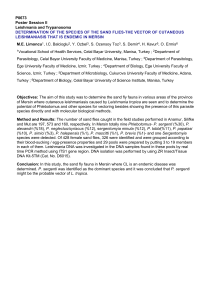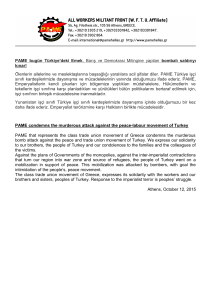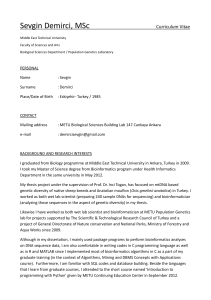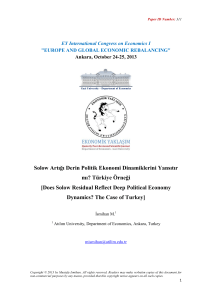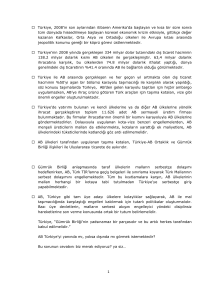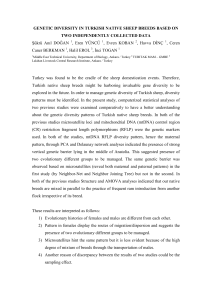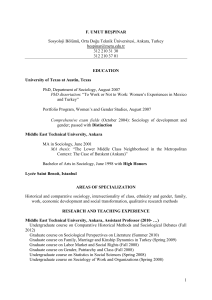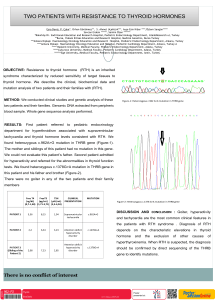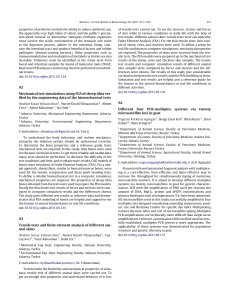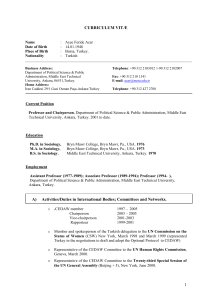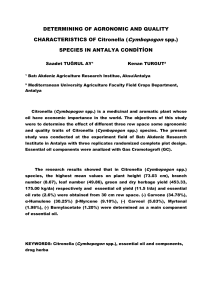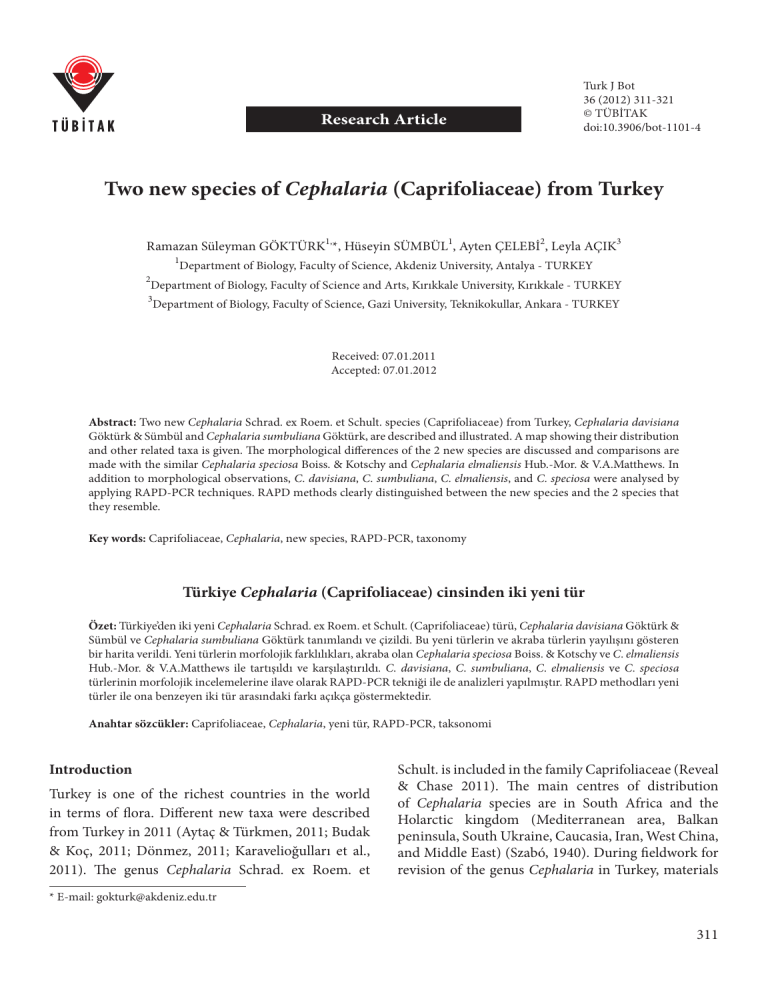
R. S. GÖKTÜRK, H. SÜMBÜL, A. ÇELEBİ, L. AÇIK
Research Article
Turk J Bot
36 (2012) 311-321
© TÜBİTAK
doi:10.3906/bot-1101-4
Two new species of Cephalaria (Caprifoliaceae) from Turkey
Ramazan Süleyman GÖKTÜRK1,*, Hüseyin SÜMBÜL1, Ayten ÇELEBİ2, Leyla AÇIK3
1
Department of Biology, Faculty of Science, Akdeniz University, Antalya - TURKEY
2
Department of Biology, Faculty of Science and Arts, Kırıkkale University, Kırıkkale - TURKEY
3
Department of Biology, Faculty of Science, Gazi University, Teknikokullar, Ankara - TURKEY
Received: 07.01.2011
Accepted: 07.01.2012
Abstract: Two new Cephalaria Schrad. ex Roem. et Schult. species (Caprifoliaceae) from Turkey, Cephalaria davisiana
Göktürk & Sümbül and Cephalaria sumbuliana Göktürk, are described and illustrated. A map showing their distribution
and other related taxa is given. The morphological differences of the 2 new species are discussed and comparisons are
made with the similar Cephalaria speciosa Boiss. & Kotschy and Cephalaria elmaliensis Hub.-Mor. & V.A.Matthews. In
addition to morphological observations, C. davisiana, C. sumbuliana, C. elmaliensis, and C. speciosa were analysed by
applying RAPD-PCR techniques. RAPD methods clearly distinguished between the new species and the 2 species that
they resemble.
Key words: Caprifoliaceae, Cephalaria, new species, RAPD-PCR, taxonomy
Türkiye Cephalaria (Caprifoliaceae) cinsinden iki yeni tür
Özet: Türkiye’den iki yeni Cephalaria Schrad. ex Roem. et Schult. (Caprifoliaceae) türü, Cephalaria davisiana Göktürk &
Sümbül ve Cephalaria sumbuliana Göktürk tanımlandı ve çizildi. Bu yeni türlerin ve akraba türlerin yayılışını gösteren
bir harita verildi. Yeni türlerin morfolojik farklılıkları, akraba olan Cephalaria speciosa Boiss. & Kotschy ve C. elmaliensis
Hub.-Mor. & V.A.Matthews ile tartışıldı ve karşılaştırıldı. C. davisiana, C. sumbuliana, C. elmaliensis ve C. speciosa
türlerinin morfolojik incelemelerine ilave olarak RAPD-PCR tekniği ile de analizleri yapılmıştır. RAPD methodları yeni
türler ile ona benzeyen iki tür arasındaki farkı açıkça göstermektedir.
Anahtar sözcükler: Caprifoliaceae, Cephalaria, yeni tür, RAPD-PCR, taksonomi
Introduction
Turkey is one of the richest countries in the world
in terms of flora. Different new taxa were described
from Turkey in 2011 (Aytaç & Türkmen, 2011; Budak
& Koç, 2011; Dönmez, 2011; Karavelioğulları et al.,
2011). The genus Cephalaria Schrad. ex Roem. et
Schult. is included in the family Caprifoliaceae (Reveal
& Chase 2011). The main centres of distribution
of Cephalaria species are in South Africa and the
Holarctic kingdom (Mediterranean area, Balkan
peninsula, South Ukraine, Caucasia, Iran, West China,
and Middle East) (Szabó, 1940). During fieldwork for
revision of the genus Cephalaria in Turkey, materials
* E-mail: [email protected]
311
Two new species of Cephalaria (Caprifoliaceae) from Turkey
of the studied taxa were collected by the senior author
from Kahramanmaraş (C. davisiana) in 2001 and
from Konya (C. sumbuliana) in 2000.
Molecular markers successfully developed in
recent years have largely overcome the problems that
are associated with phenotype-based classification
of plants. PCR-based techniques such as random
amplified polymorphic DNA (RAPDs) are used to
identify polymorphism between and among species.
Amplified fragment length polymorphisms (AFLP)
provide DNA markers that are dispersed throughout
plant genomes and are easier to reproduce and analyse
(Awasthi et al., 2004). RAPD is a polymerase chain
reaction derived marker with nonspecific random
primers. This technique has become popular as
researchers do not need sequence information of the
genome for the target plan for animal species (Nybom,
2004). The RAPD method was introduced in 1990
by Williams et al. (1990). DNA bands produced by
the RAPD technique indicate dominantly inherited
markers, but it does not distinguish heterozygous
from homozygous (a band is present or absent). Most
researchers use polymorphic bands in the assessment
of genetic diversity. However, in order to compare
closely related taxa, monomorphic and polymorphic
bands are included in this RAPD approach to plant
systematics (Williams et al., 1990; Çelebi et al., 2009;
Kavalcıoğlu et al., 2010). The sampling strategies are
also very important. The increase in number of plants
per population had a significant positive effect on the
calculation of genetic diversity as well as increasing
the number of primers tested. The advantages of
these techniques are their simplicity, rapidity, and
ability to detect extensive polymorphisms from small
amounts of genomic DNA (Hu & Quiros, 1991).
Cephalaria davisiana Göktürk & Sümbül, C.
sumbuliana Göktürk, C. speciosa Boiss. & Kotschy, and
C. elmaliensis Hub.-Mor. & V.A.Matthews are more
closely related to each other than to the remaining
species. Cephalaria speciosa is an endemic species
found in eastern Anatolia in Turkey. Cephalaria
elmaliensis is a narrowly endemic species that is a
constituent of the Mediterranean element and grows
in small area in Çığlıkara (Elmalı, Antalya) in Turkey.
The hypothesised new taxa C. davisiana and C.
sumbuliana and the other related species C. speciosa
and C. elmaliensis were studied morphologically and
then using molecular techniques.
The RAPD-PCR technique was then employed to
differentiate the 2 new species and their 2 related taxa.
In order to evaluate whether the proposed taxa really
do represent 2 new Cephalaria species, we analysed
and compared samples of 2 new species with closely
allied species C. speciosa and C. elmaliensis using 22
RAPD primers.
Materials and methods
In total, 22 specimens (27 individuals) of C. davisiana
and 34 specimens (41 individuals) of C. sumbuliana
were collected from the type localities and deposited
in Akdeniz Univ. Herb., ANK, GAZI, and HUB.
C. davisiana, C. sumbuliana, C. elmaliensis, and
C. speciosa were compared using the RAPD-PCR
technique (Table 1). Total genomic DNA was isolated
Table 1. The voucher specimens of the Cephalaria species used in RAPD analyses and their localities.
Species
Locality
C. davisiana
C6 Kahramanmaraş: between Göksun and Sarız, east of Doğankonak village, Binboğa mountain, mountain
slopes, 1700-2000 m, 3.8.2001, R.S.Göktürk 4733 & M.Göktürk (Akdeniz Univ. Herb.).
C. sumbuliana
C4 Konya: Seydişehir, 21 km from Seydişehir to Akseki, rocky places, under and clearings in Abies forest, 1435
m, 8.8.2000, R.S.Göktürk 4466 & F.Göktürk (Akdeniz Univ. Herb.).
C. elmaliensis
C2 Antalya: Elmalı, Çığlıkara, near security building, rocky places and opening C. libani forest, 1900 m,
12.8.1995, R.S.Göktürk 3532 (Akdeniz Univ. Herb.).
C. speciosa
B8 Erzincan: 30 km from Erzincan to Sivas, roadside, 1500 m, 17.viii.2000, R.S.Göktürk 4531 & F.Göktürk
(Akdeniz Univ. Herb.).
312
R. S. GÖKTÜRK, H. SÜMBÜL, A. ÇELEBİ, L. AÇIK
from the fresh leaf tissue of plants using the methods
of Waugh (1997), with minor modifications. DNA
was isolated from liquid nitrogen frozen tissue. Fresh
young leaves (0.05 g) or dried leaves were ground
using a mortar. The grindate was added to 1 mL of
extraction buffer (2% (w/v) CTAB; 100 mM TrisCl buffer (pH 8.0), 20 mM EDTA (pH 8.0), 1.4 M
NaCl, (1% 8w/v) PVP-40) and incubated at 65 °C
for 90 min. The extract was mixed with 500 (24:1)
μL chloroform:isoamyl alcohol (v/v) and mixed
well by gentle inversion. Following centrifugation
at 10,000 rpm for 10 min, the upper aqueous layer
was transferred to a fresh tube containing 600 μL of
isoproponal; the mixture was then left to sit at room
temperature for 40 min. After being centifuged for
20 min the pellets were left to sit overnight at room
temperature and were resuspended in TE buffer
(10 mM Tris-Cl, pH 8.0, 1 mM EDTA pH 8.0). The
selected 22 out of 40 arbitrary primers were used
(purchased from Operon Technologies, Alameda,
CA, USA) (Table 2). Amplification reactions were
performed using the protocol reported by Williams
et al. (1990). At least 3 or 4 samples representing
each taxon were used for amplification; amplification
was performed twice for each sample. For the DNA
amplification, a Biometra thermocycler (T Personel
Germany) was programmed for 45 cycles at 96 °C for
30 s, 35 °C for 30 s, and 72 °C for 30 s, for denaturing,
annealing, and primer extension, respectively.
Following the procedure, 20 μL of the samples were
loaded in 2% agarose gels in 1X TAE buffer and run
at 75 V for about 4 h. A 1 kb DNA ladder was used
as molecular weight markers. The gel was stained
with ethidium bromide and photographed under UV
light (Maniatis et al., 1982). The images were used for
the analysis of the amplification products. Only the
reproducible bands in multiple runs were considered
in this study. Out of 22, only 11 primers that showed
the best readability were chosen for calculation.
Bands on RAPD gels were scored as either present
(1) or absent (0) for all species studied. Common
band analysis was conducted using the computer
software POPGEN (Dendrogram Based Nei’s (1978).
UPGMA-Modified from NEIGHBOR procedure of
PHYLIP Version 3) to determine the genetic distance
between them. The values for genetic distance were
then used in cluster analysis to generate dendrograms
(Nei, 1978).
Cephalaria davisiana Göktürk & Sümbül, sp.
nov. (Figure 1).
Type: Turkey, C6 Kahramanmaraş: between
Göksun and Sarız, east of Doğankonak village,
Binboğa mountain, mountain slopes, 1700-2000 m,
3.8.2001, R.S.Göktürk 4733 & M.Göktürk (holotype:
Akdeniz Univ. Herb., isotypes: ANK, GAZI, HUB).
Paratype: Turkey, C6 Kahramanmaraş: between
Göksun and Sarız, east of Doğankonak village,
Binboğa mountain, mountain slopes, 1700-2000 m,
9.8.1995, R.S.Göktürk 3508 & M.R.Tunç (Akdeniz
Univ. Herb., ANK, GAZI, HUB).
Table 2. Primers used in this study.
Primer no.
Primer sequence (5→3’)
Primer no.
Primer sequence (5→3’)
A1
CAGGCCCTTC
OPB 05
TGCGCCCTTC
A2
TGCCGAGCTG
OPB 08
GTCCACACGG
A7
GAAACGGGTG
OPO 04
AAGTCCGCTC
LA12
ACGACCCACG
OPO 06
CCACGGGAAG
LA13
CACCACGCCT
OPW 06
AGGCCCGATG
SC1023
GGCTCGTACC
OPW 10
TCGCATCCCT
SC1079
CGCCACGTTC
OPC 02
GGTCTACACC
B4
GGACTGGAGT
OPR 03
ACACAGAGGGT
B6
TGCTCTGCCC
OPB 10
CTGCTGGGAC
B7
GGTGACGCAG
OPU 16
CTGCGCTGGA
B18
CCACAGCAGT
M13
GAGGGTGGCGGTTCT
313
Two new species of Cephalaria (Caprifoliaceae) from Turkey
B
C
3 mm
3 mm
D
E
3 mm
3 mm
5 cm
A
Figure 1. Cephalaria davisiana (from the holotype). A- Habit, B- involucral bract, Creceptacular bract, D- corolla, E- involucel.
Diagnosis: Affinis Cephalariae speciosa sed
foliis inferioribus simplicibus vel lyratis (non solum
simplicibus), bracteis involucralibus ovatis-orbicularis
vel triangulis-ovatis omnino nigris vel atris in
dorsalis et ad apicem, acutibus vel subacutibus ad
apicem (non ovatis triangularibus-lanceolatibus,
omnino stramineis, acuminatis vel subacuminatis ad
apicem), bracteis receptacularibus ovatis-oblongis,
atris ad apicem (non triangularis-lanceolatis, omnino
stramineis) differt.
Stout, erect perennial herbs. Stem up to 1.5 m,
simple, striate, covered with densely stellate hairs,
314
and densely retrorse stellate hairs in lower part and
beneath capitula. Leaves coriaceous, hairy; lower
leaves simple or lyrate, simple leaves and segments of
lyrate leaves margin entire or crenate-serrate, acute or
acuminate at apex, oblong-lanceolate or oblong, 1034 × 4-7 cm, lyrate leaves oblong-lanceolate in outline,
12-50 × 3.5-12 cm with 2-6 lanceolate segment; lateral
segments, 1-5.5 × 0.8-2.5 cm, terminal segment larger
than lateral ones, oblong-lanceolate, 8-28 × 4-8 cm;
stem leaves lyrate, lanceolate or oblong-lanceolate in
outline, 8-25 × 2-8 cm, with 2-6 lanceolate segments,
1-3 × 0.2-1.2 cm, entire, acute or subacuminate at
R. S. GÖKTÜRK, H. SÜMBÜL, A. ÇELEBİ, L. AÇIK
and some non-endemic plants such as Cephalaria
stellipilis Boiss., Acantholimon armenum Boiss. &
A.Huet. var. balansae Boiss. & A.Huet., Pelargonium
endlicherianum Fenzl, Hieracium pannosum Boiss.,
and Potentilla speciosa Willd. var. speciosa. It flowers
in July-September and fruits in August-September.
apex, terminal segment larger than lateral ones,
oblong-lanceolate or lanceolate, 5-18 × 2-6 cm,
margins entire or crenate-serrate, acute or acuminate
at apex; upper leaves simple or lyrate, sessile; simple
leaves and segments of lyrate leaves margins entire,
acuminate or subacuminate at apex; simple leaves
linear or linear-lanceolate, 0.7-4.2 × 0.2-0.8 cm; lyrate
leaves lanceolate or oblong-lanceolate in outline, 1.26 × 0.2-0.8 cm, with 2-4 linear segment, 0.2-0.5 ×
0.1-0.2 cm, terminal segment larger than lateral ones,
linear-lanceolate, 1-5 × 0.2-0.7 cm. Peduncle 5-40 cm
long. Capitula globose, 30-50-flowered, 1.5-2.5 cm in
diam. in flower, 1.5-3 cm in diam. in fruit. Involucral
bracts ovate-orbicular or triangular-ovate, 6-9 × 4-8
mm, completely blackish or blackish in dorsal side
and at apex, pubescent or adpressed pilose, margins
long ciliate, acute or subacute at apex; receptacular
bracts ovate-oblong, 8-11 × 3-5 mm, straw-coloured
in dorsal side and base, black at apex, pubescent or
sparsely adpressed pilose, margins ciliate, acuminate
or subacuminate at apex. Calyx cupuliform, 1-2 mm
in diameter, with irregular teeth. Corolla 8-14 mm
long, yellow or pale yellow, densely adpressed hairy
outside. Involucel 4 angled, 7-14 mm long in fruit,
pilose, 4 long and 4 short teeth at apex, long teeth
3-3.5 mm long, short teeth 1-1.5 mm long.
Specimens examined:
Cephalaria
davisiana:
Turkey,
B6
Kahramanmaraş: Göksun, Fındık köyü, Kandil Dağı,
kuzey yamaç, orman içi ve açıklığı, 1600-2100 m,
27.7.1981, B.Yıldız 3068 (HUB). B6 Kayseri: Sarız,
Yeşilyurt, Binboğa Dağı, kayalık yerler, 1800 m,
9.8.1995, R.S.Göktürk 3502 & M.R.Tunç (Akdeniz
Univ. Herb.); C6 Kahramanmaraş: Göksun, Binboğa
Dağı, Yalak, ca. 2000 m, Davis 20159 (ANK); Ahır
Dağı, Akdere mevkii, Yalnız ardıç bağları çevresi,
yüksek dağ stebi, 1400 m, 13.9.1991, Z.Aytaç 5552
& H.Duman (GAZI); Göksun, Değirmendere,
Büyükçamurlu-Yanıktepe arası, taşlı yamaçlar, 1600
m, 20.8.1993, M.Ekici 1694 (GAZI); Göksun-Maraş
arası, Püren geçidi, kayalık yerler, 1550 m, 5.8.2003,
R.S.Göktürk 5153. (Akdeniz Univ. Herb.).
Cephalaria speciosa Boiss. & Kotschy: Turkey, B7
Erzincan: Keşiş Dağı, Cimin, kayalık yamaçlar, ca.
2300 m, 28.8.1957, Davis 31828 (ANK); Yaylabaşı
Köyü, Kazankaya Dağı, 1500-2300 m, 7.8.1980,
Ş.Yıldırımlı 3861 (HUB); Kemah, Kömürköy yukarısı,
bozkır açıklığı, 1850 m, 31.7.1996, A.A.Dönmez 5367
(HUB). B7 Tunceli: Ovacık, Munzur Dağı, Aksu
Deresi, ca. 1700 m, 21.7.1957, Davis 31462 & Hedge
(ANK); B7 Tunceli: Ovacık, Munzur Dağı, Karagöl
Distribution, ecology, and phenology. Cephalaria
davisiana is endemic to South Anatolia (Figure 2).
It is associated with endemics such as Michauxia
tchihatchewii Fisch. & C.A.Mey., Silene brevicaulis
Boiss., Onosma polioxanthum Rech.f., Lamium
garganicum L. subsp. nepetifolium (Boiss.) R.R.Mill,
1
2
3
4
5
6
7
8
9
10
42°
İstanbul
A
40°
Ankara
B
Van
38°
Antalya
C
0
26°
28°
30°
32°
34°
36°
38°
10
40°
20 km
42°
36°
44°
Figure 2. Distribution of C. davisiana (▲), C. sumbuliana (z), C. speciosa (), and C.
elmaliensis ({) in Turkey.
315
Two new species of Cephalaria (Caprifoliaceae) from Turkey
vadi, 1350-1500 m, 8.9.1979, Ş.Yıldırımlı 2443 (HUB).
B8 Erzincan: Aşkale-Tercan, kuru kayalık yamaçlar,
ca. 1700 m, 25.8.1957, Davis 32657 & Hedge (ANK);
Tercan, Tercan-Aşkale arası, Erzincan-Erzurum il
sınırı, tünele 250 m kala, yamaçlar, 1765 m, 17.8.2000,
R.S.Göktürk 4528 & F.Göktürk (Akdeniz Univ.
Herb.); Erzincan-Sivas karayolu 30. km’si, 3. tünelin
ilerisi, yol kenarı, 1500 m, 17.8.2000, R.S.Göktürk
4531 & F.Göktürk (Akdeniz Univ. Herb.). B8 Muş:
Muş-Solhan, hillsides, ca. 1350 m, 31.8.1954, Davis
24783 & Polunin (ANK); Varto, Muş-Varto arası,
Varto’ya 10-12 km kala, kayalık yamaçlar, 1350 m,
2.8.2001, R.S.Göktürk 4727 & M.Göktürk (Akdeniz
Univ. Herb.); Varto, Varto-Erzurum yolu 12 km,
Seferek Geçidi, kayalık yamaçlar, 1800 m, 2.8.2001,
R.S.Göktürk 4730 & M. Göktürk (Akdeniz Univ.
Herb.); Muş-Solhan arası, Solhan’a 13 km kala,
yol kenarı, 1600 m, 2.8.2001, R.S.Göktürk 4732 &
M.Göktürk (Akdeniz Univ. Herb.).
Etymology. The new species is named in honour
of Prof. Dr. P. H. Davis, late editor of Flora of Turkey.
Recommended IUCN threat category. It should
be graded as Vulnerable (VU) (IUCN 2006), because
the estimated area of occupancy is less than 20,000
km2 (criterion B1) and it is known to exist at no more
than 10 locations (criterion B1a).
Cephalaria sumbuliana Göktürk, sp. nov. (Figure 3).
Type: Turkey, C4 Konya: Seydişehir, 21 km
from Seydişehir to Akseki, rocky places, under
and clearings in Abies forest, 1435 m, 8.8.2000,
R.S.Göktürk 4466 & F.Göktürk (holotype: Akdeniz
Univ. Herb., isotypes: ANK, GAZI, HUB).
Paratypes: Turkey, C4 Konya: Seydişehir,
Seydişehir-Akseki yolunun 21. km’si, kayalık yerler,
Abies altı ve açıklıkları, 1435 m, 4.7.2002, R.S.Göktürk
4865 & F.Göktürk (Akdeniz Univ. Herb.); Seydişehir,
Seydişehir-Akseki yolunun 21. km’si, kayalık yerler,
Abies altı ve açıklıkları, 1435 m, 1.8.2002, R.S.Göktürk
5040 & M.Göktürk (Akdeniz Univ. Herb.).
Diagnosis. Affinis Cephalariae elmaliense et
Cephalariae speciosa, sed Cephalariae elmaliense
caulibus crassis, rhizomatois (non gracilibus, non
rhizomatois), bracteis involucralibus late ovatisorbicularibus vel orbicularibus, obtusibus ad
apicem (non ovatis, acutibus ad apicem), bracteis
receptacularibus oblongis vel angustis oblanceolatis
316
(non angustis ovatis vel lanceolatis) et Cephalariae
speciosa caulibus rhizomatois (non rhizomatois),
bracteis involucralibus late ovatis-orbicularibus vel
orbicularibus solum longis pilosis, obtusibus ad apicem
(non ovatis triangularibus-lanceolatis pubescentibus
et adpressis pilosis, acuminatis vel subacuminatis ad
apicem), bracteis receptacularibus oblongis vel anguste
oblanceolatis, acutis vel brevis acuminatis ad apicem
(non triangularibus-lanceolatis, acuminatibus ad
apicem) differt.
Stout, rhizomatous, erect perennial herbs. Stem up
to 1.3 m, simple, striate, densely stellate hairy, densely
retrorse stellate hairy in lower part and beneath
capitula. Leaves coriaceous, densely stellate hairy;
lower leaves lyrate, lanceolate or ovate-lanceolate
in outline, 5-44 × 3.5-13 cm, with 2-6 oblong or
oblong-lanceolate segments, 2-5 × 0.3-2.5 cm, entire
or crenate-serrate, acute or obtuse at apex, terminal
segment larger than lateral ones, oblong-lanceolate
or lanceolate, 8-28 × 2-6 cm, crenate or crenateserrate, acute at apex; stem leaves lyrate, lanceolate or
oblong-lanceolate in outline, 9-20 × 3-10 cm, with 2-6
oblong-lanceolate segments, 2-6 × 0.5-2 cm, entire or
crenate-serrate, acute at apex, terminal segment larger
than lateral ones, oblong-lanceolate or lanceolate,
6.5-13 × 1.5-4.5 cm; upper leaves simple or lyrate,
sessile; simple leaves and segments of lyrate leaves
margins entire, subacuminate at apex; simple leaves
linear or linear-lanceolate, 0.8-3 × 0.1-0.4 cm; lyrate
leaves linear-lanceolate or lanceolate in outline, 2-8 ×
1.2-2 cm, with 2-4 linear segments, 0.5-1.5 × 0.1-0.4
cm, terminal segment larger than lateral ones, linearlanceolate, 2.5-7 × 0.3-0.9 cm. Peduncle 5-35 cm long.
Capitula globose, 1-2 cm in diam. in flower, 1.5-2.5
cm in diam. in fruit. Involucral bracts broadly ovateorbicular or orbicular, 6-9 × 5-9 mm, straw-coloured,
long pilose hairy, margins long ciliate, obtuse at apex;
receptacular bracts oblong or narrowly oblanceolate,
8-12 × 3-4 mm, straw-coloured, pubescent or
adpressed pilose hairy, margins ciliate, acute or short
acuminate at apex. Calyx cupuliform, 1.5-2.5 mm
in diameter, subirregular teeth. Corolla 8-12 mm
long, cream or pale yellow, densely adpressed hairy
outside. Involucel 4 angled, 7-10 mm long in fruit,
striate, densely adpressed pilose hairy, 4 long and 4
short teeth at apex, long teeth 3-3.5 mm long, short
teeth 1-1.5 mm long.
R. S. GÖKTÜRK, H. SÜMBÜL, A. ÇELEBİ, L. AÇIK
3 mm
5 cm
B
3 mm
C
A
3 mm
3 mm
D
E
Figure 3. Cephalaria sumbuliana (from the holotype). A- Habit, B- involucral
bract, C- receptacular bract, D- corolla, E- involucel.
Distribution, ecology, and phenology. Cephalaria
sumbuliana is endemic to South Anatolia (Figure 2). It
is associated with endemics such as Abies cilicica (Ant.
& Kotschy) Carr. subsp. isaurica Coode & Cullen,
Centaurea isaurica Hub.-Mor., Iris schachtii Markgr.,
Geranium glaberrimum Boiss. & Heldr., and some
non-endemic plants such as Allium orientale Boiss.,
Cephalaria dipsacoides Boiss. & Balansa, Pelargonium
endlicherianum Fenzl, Xeranthemum annuum L.,
Silene compacta Fisch., Lonicera nummulariifolia
Jaub. & Spach subsp. nummulariifolia, Rosa canina L.,
and Berberis crataegina DC. It flowers in July-August
and fruits in August-September.
Specimens examined:
Cephalaria sumbuliana: Turkey, C4 Konya:
Ermenek, Kazancı Kasabası Yaylası, Kırk kuyu
mevkii, 1800 m, 19.7.1984, H.Sümbül 3217 (HUB).
Cephalaria
elmaliensis
Hub.-Mor.
&
V.A.Matthews: Turkey, C2 Antalya: Elmalı, Çığlıkara,
bekçi kulübesi civarı, Cedrus libani açıklıkları,
1700-1900 m, 25.8.1993, H.Duman 5345, Z.Aytaç &
A.A.Dönmez (GAZI, Akdeniz Univ. Herb.); Elmalı,
Çığlıkara, bekçi kulübesi civarı, kayalık yerler ve C.
libani açıklıkları, 1900 m, 12.8.1995, R.S.Göktürk
3532 (Akdeniz Univ. Herb.).
317
Two new species of Cephalaria (Caprifoliaceae) from Turkey
Cephalaria speciosa Boiss. & Kotschy: Turkey, B7
Erzincan: Keşiş Dağı, Cimin, kayalık yamaçlar, ca.
2300 m, 28.8.1957, Davis 31828 (ANK); Yaylabaşı
Köyü, Kazankaya Dağı, 1500-2300 m, 7.8.1980,
Ş.Yıldırımlı 3861 (HUB); Kemah, Kömürköy yukarısı,
bozkır açıklığı, 1850 m, 31.7.1996, A.A.Dönmez 5367
(HUB). B7 Tunceli: Ovacık, Munzur Dağı, Aksu
Deresi, ca. 1700 m, 21.7.1957, Davis 31462 & Hedge
(ANK); B7 Tunceli: Ovacık, Munzur Dağı, Karagöl
vadi, 1350-1500 m, 8.9.1979, Ş.Yıldırımlı 2443 (HUB).
B8 Erzincan: Aşkale-Tercan, kuru kayalık yamaçlar,
ca. 1700 m, 25.8.1957, Davis 32657 & Hedge (ANK);
Tercan, Tercan-Aşkale arası, Erzincan-Erzurum il
sınırı, tünele 250 m kala, yamaçlar, 1765 m, 17.8.2000,
R.S.Göktürk 4528 & F.Göktürk (Akdeniz Univ. Herb.);
Erzincan-Sivas karayolu 30. km’si, 3. tünelin ilerisi,
yol kenarı, 1500 m, 17.8.2000, R.S.Göktürk 4531 &
F.Göktürk (Akdeniz Univ. Herb.). B8 Muş: MuşSolhan, hillsides, ca. 1350 m, 31.8.1954, Davis 24783
& Polunin (ANK); Varto, Muş-Varto arası, Varto’ya
10-12 km kala, kayalık yamaçlar, 1350 m, 2.8.2001,
R.S.Göktürk 4727 & M.Göktürk (Akdeniz Univ. Herb.);
Varto, Varto-Erzurum yolu 12. km, Seferek Geçidi,
kayalık yamaçlar, 1800 m, 2.8.2001, R.S.Göktürk 4730
& M.Göktürk (Akdeniz Univ. Herb.); Muş-Solhan
arası, Solhan’a 13 km kala, yol kenarı, 1600 m, 2.8.2001,
R.S.Göktürk 4732 & M.Göktürk (Akdeniz Univ. Herb.).
Etymology. The new species is named in honour
of Prof. Dr. Hüseyin Sümbül, plant taxonomist at
Akdeniz University, Faculty of Science, Antalya,
Turkey.
Recommended IUCN threat category. It should
be graded as Critically Endangered (CR) (IUCN
2006), because the estimated area of occupancy is
less than 100 km2 (criterion B1) and the population
of the new species is estimated to number less than
250 mature individuals (criterion C).
A morphological key of Cephalaria
1. Plant stout, longer than 1 m high
2. Lower leaves simple
3. Lower leaves deflexed from petiolate;
capitula globose, 2-2.5 cm in flower ……..
……...................................……C. duzceёnsis
3. Lower leaves not deflexed from petiolate;
capitula ovate-globose, 2.5-4.5 cm in
flower…………..................……..C. speciosa
318
2. Lower leaves lyrate
4. All bracts blackish at apex; involucral bracts
acute or subacute; receptacular bracts
ovate-oblong…...……………..C. davisiana
4. All bracts straw-coloured at apex; involucral
bracts obtuse; receptacular bracts oblong or
narrowly oblanceolate…...…C. sumbuliana
1. Plant slender, up to 1 m high
5. Lower and stem leaves oblong-spathulate……
………........................................……C. stellipilis
5. Lower and stem leaves lanceolate
6. Capitula ovoid; involucral bracts ovateorbicular or orbicular; involucel sericeous
…………….........................…..C. elazigensis
6. Capitula subglobose; involucral bracts
ovate; involucel pilose….........C. elmaliensis
Results and discussion
In Table 3, C. davisiana, C. sumbuliana, C. speciosa,
and C. elmaliensis are compared on the basis of their
vegetative organs (stem and leaves) and reproductive
organs (capitula, involucral bracts, receptacular
bracts, and corolla).
Cephalaria was previously revised by Matthews
for the Flora of Turkey (29 species) (Matthews, 1972).
Since then, 9 new species have been described from
Turkey: (Davis et al., 1988; Sümbül, 1991; Göktürk
& Sümbül, 1997; Göktürk et al., 2003; Göktürk
& Sümbül, 2003; Kuş & Göktürk, 2005; Aksoy et
al., 2007). In a revision of the genus Cephalaria in
Turkey, the species C. amana Rech.f. was treated
as a synonym of C. taurica Szabó species by the
senior author (RSG). The total number of species of
Cephalaria reported from Turkey is now 39.
An attempt was made to assess the relationships
among 4 Cephalaria species using a molecular
approach based on RAPD-PCR analysis. For the
RAPD-PCR analysis 22 random primers were tested
in the amplification reactions with Cephalaria species.
Among them, 11 primers were chosen for further
analysis. The 11 RAPD primers (M13, B7, B6, OPC
02, OPB 05, OPW 06, OPW 10, OPO 04, SC 1023, SC
1079, and A2) generated a total of 74 fragments from
R. S. GÖKTÜRK, H. SÜMBÜL, A. ÇELEBİ, L. AÇIK
Table 3. Morphological comparison of Cephalaria davisiana and C. sumbuliana with C. speciosa, and C. elmaliensis.
Characters
C. davisiana
C. sumbuliana
C. speciosa
C. elmaliensis
Stem
non rhizomatous
rhizomatous
non rhizomatous
non rhizomatous
Lower leaves
simple or lyrate,
oblong-lanceolate
lyrate, lanceolate or ovatelanceolate
simple, oblong-lanceolate
simple, lanceolate
Stem leaves
lyrate
lyrate
lyrate
simple or lyrate
Upper stem leaves
simple or lyrate
simple or lyrate
simple or lyrate
simple
Capitula
globose,
1.5-2.5 cm in
diam. in flower
globose,
1-2 cm in diam. in flower
ovate to globose,
2.5-4.5 cm in diam. in flower
subglobose,
1-2 cm in diam. in flower
shape
ovate-orbicular or
triangular-ovate
broadly ovate-orbicular or
orbicular
ovate to triangular- lanceolate ovate
size
6-9 × 4-8 mm
6-9 × 5-9 mm
7-15 × 3-7 mm
4-6 × 2.5-3 mm
colour
completely blackish or
blackish in dorsal side
and at apex
completely straw-coloured
completely straw-coloured
completely straw-coloured
or only brown at apex
apex
shape
acute or subacute
obtuse
acuminate or subacuminate
acute
shape
ovate-oblong
oblong or narrowly
oblanceolate
triangular-lanceolate
ovate or lanceolate
size
8-11 × 3-5 mm
8-12 × 3-4 mm
12-20 × 3.5-6 mm
8-12 × 2-3 mm
blackish at apex
completely straw-coloured
completely straw-coloured
straw-coloured at base and
brown at apex
acuminate or subacuminate acute or short acuminate
acuminate
acuminate
yellow or pale yellow
cream or pale yellow
yellow or cream
Involucral
bracts
Receptacular
bracts
colour
apex
shape
Corolla
cream or pale yellow
patterns of the 4 Cephalaria species. The approximate
size of the fragments ranged from 100 to 900 bp
(Figure 4). The total number of amplified bands per
primer varied from 3 (B7 and B6) to 13 (OPC 02)
with an average of 6.7 fragments per primer.
For the data analysis, different fragments
produced with each primer on the gel were numbered
sequentially and presence and absence of fragments
in each sample was scored (present 1, absent 0).
Genetic distances were calculated using Nei’s genetic
distance: Method UPGMA. The results are given in
Table 4. The dissimilarity coefficients were used to
cluster the data using algorithm of unweighted pair
group method with arithmetic averages (UPGMA)
in a dendrogram (Figure 5). Cephalaria species
showed a clear separation from each other, and
formed 2 main clusters. The first cluster includes
C. speciosa, C. sumbuliana (putative new species),
and C. elmaliensis. The second cluster includes only
C. davisiana. C. davisiana would appear to be 59%
different from C. elmaliensis, 72% different from
C. speciosa, and 87% different from C. sumbuliana.
Molecular and morphological analysis together
indicate that C. davisiana appears to be genetically
distant from C. speciosa.
RAPD analysis showed the capabilities of primer
screened to determine the variability among 2
putative new species and 2 resembling species. The
319
Two new species of Cephalaria (Caprifoliaceae) from Turkey
C. davisiana
C. speciosa
C. sumbuliana
C. elmaliensis
Figure 4. RAPD profiles of Cephalaria species with OPC02
primer. M: Marker (100 bp DNA Ladder), Cs: C.
sumbuliana, Ce: C. elmaliensis, Csp: C. speciosa, Cd: C.
davisiana.
Figure 5. Dendrogram based on genetic distances between
Cephalaria species.
Table 4. Genetic distances based on RAPD results of Cephalaria species.
C. sumbuliana
C. elmaliensis
C. speciosa
C. sumbuliana
***
C. elmaliensis
0.4329
***
C. speciosa
0.5429
0.4539
***
C. davisiana
0.8701
0.5905
0.7205
interspecific genetic distances for each species vary
from 43% to 87%. C. davisiana and C. sumbuliana
were the most divergent species, with a distance
of 0.87. The lowest genetic distance among the
different species was observed between C. elmaliensis
and C. sumbuliana (0.43). The results suggest that
Cephalaria spp. (C. davisiana and C. sumbuliana) are
very different from the other 2 related species based
on RAPD results.
Acknowledgements
We wish to thank TÜBİTAK (Project Number
TBAG-2074) for financial support, Dr. O. Ünal
320
C. davisiana
***
(Akdeniz University) and Dr. D. Şirin (Namık Kemal
University) for preparing the illustrations, Dr. R.
Tekoğlu (Akdeniz University) for help with the
Latin diagnosis, and the Curators of the Herbaria
Ankara University (ANK), Gazi University (GAZI),
and Hacettepe University (HUB), who allowed us
to study their Cephalaria specimens. This paper was
produced from a project (number: 21.01.0121.24)
supported by the Scientific Research Projects Unit of
Akdeniz University. The authors gratefully thank Dr.
Brian Mathew for checking the English and helpful
comments on the manuscript. We are also grateful for
financial support to The State Planning Organisation
(Grant 1998K121480).
R. S. GÖKTÜRK, H. SÜMBÜL, A. ÇELEBİ, L. AÇIK
References
Aksoy N, Göktürk RS, Açık L & Çelebi A (2007). Cephalaria
duzceёnsis (Dipsacaceae), a new species from the western Black
Sea Region, Turkey. Nordic Journal of Botany 25: 64-69.
IUCN (2006). IUCN Red List Categories and Criteria: Version
6.2. IUCN Species Survival Commission. IUCN, Gland. UK:
Switzerland and Cambridge.
Aytaç Z & Türkmen Z (2011). A new Onosma (Boraginaceae) species
from southern Anatolia, Turkey. Turkish Journal of Botany 35:
269-274.
Karavelioğulları FA, Çelik S, Başer B & Yavru A (2011). Verbascum
ergin-hamzaoglui (Scrophulariaceae), a new species from
South Anatolia, Turkey. Turkish Journal of Botany 35: 275-283.
Awasthi AK, Nagaraja GM, Naik GV, Kanginakudru S, Thangavelu
K & Nagaraju J (2004). Genetic diversity and realationships
in mulberry (genus Morus) as revealed by RAPD and ISSR
marker assays. BMC Genetics 5: 2-9.
Kavalcıoğlu N, Açık L & Pınar NM (2010). Comparative RAPD
analysis and pollen structure studies of Bellis perennis L.
Turkish Journal of Botany 34: 479-484.
Budak Ü & Koç M (2011). Silene hamzaoglui (Caryophyllaceae), a
new species from Çekerek (Yozgat/Turkey). Turkish Journal of
Botany 35: 285-289.
Çelebi A, Karavelioglu F, Açık L & Celep F (2009). Taxonomic
relationships in Turkish Verbascum L. Group A
(Scrophulariaceae): evidence from SDS-PAGE of seed
proteins and a numerical taxonomic study. Turkish Journal of
Biochemistry 34: 234-241.
Davis PH, Mill RR & Tan K (1988). Cephalaria Schrader ex Roemer
et Schultes. In Davis PH, Mill RR & Tan K (eds.), Flora of
Turkey and the East Aegean Islands, (Suppl. 1). Vol 10, p. 156,
Edinburgh: Edinburgh University Press.
Dönmez AA (2011). Cicer uludereensis Dönmez: a new species of
Cicer (Chickpea) (Fabaceae) from around the Fertile Crescent,
SE Turkey. Turkish Journal of Botany 35: 71-76.
Kuş S & Göktürk RS (2005). A new Cephalaria (Dipsacaceae) species
from the European part of Turkey. Nordic Journal of Botany
23: 427-430.
Maniatis R, Fritsch EH & Sambrook J (1982). In Molecular Cloning.
A laboratory manual. Cold Spring Harbor, New York.
Matthews VA (1972). Cephalaria Schrader ex Roemer & Schultes. In:
Davis PH, (ed.), Flora of Turkey and the East Aegean Islands
Vol. 4, pp. 585-597. Edinburgh: Edinburgh University Press.
Nei M (1978). Genetic distance between populations. The American
Naturalist 106: 283-292.
Nybom H (2004). Comparison of different nuclear DNA markers for
estimating intraspecific genetic diversity in plants. Molecular
Ecology 13: 1143-1155.
Reveal JL & Chase MW (2011). APG III: Bibliographical Information
and Synonymy of Magnoliidae. Phytotoxa 19: 71-134.
Göktürk RS & Sümbül H (1997). A new species of Cephalaria
(Dipsacaceae) from South Anatolia, Turkey. Annales Botanici
Fennici 34: 153-155.
Sümbül H (1991). Ten new species from Anatolia and two new
records for the flora of Turkey. Edinburgh Journal of Botany
48: 27-40.
Göktürk RS & Sümbül H (2003). Cephalaria aytachii (Dipsacaceae),
a new species from central Anatolia, Turkey. Annales Botanici
Fennici 40: 123-127.
Szabó Z (1940). Cephalaria-genusz monografiaja. Kiadja A Magyar
Tudomanyos Akademia, Budapest.
Göktürk RS, Sümbül H & Açık L (2003). A new species of Cephalaria
Schrader ex Roemer & Schultes (Dipsacaceae), including a
new variety from East Anatolia, Turkey. Israel Journal of Plant
Science 51: 59-65.
Hu J & Quiros F (1991). Identification of broccoli and cauliflower
cultivars with RAPD markers. Plant Cell Reports 10: 505-511.
Waugh R (1997) Extraction of whole genomic DNA by the CTAB
method. In: Clark MS. Ed, Plant molecular biology, a laboratory
manual. Springer, pp. 5-8.
Williams JGK, Kubelik AR, Livak KJ, Rafalski JA & Tingey SV (1990).
DNA polymorphisms amplified by arbitrary primers are useful
as genetic markers. Nucleic Acids Research 18: 6531-6535.
321


